Harvey K. Littleton, an acclaimed glass sculptor and printmaker, is recognized internationally for his groundbreaking work in developing and promoting American studio glass. Glass and invention came naturally to Littleton, who was born in 1922 and raised in Corning, New York. He died in his home in Spruce Pine, North Carolina on December 13, 2013.
Littleton was raised in a family steeped in glass. His father, Jesse T. Littleton, was the first physicist to join the research team headed by Eugene C. Sullivan at Corning Glass Works. His mother, Bessie Cook Littleton, was instrumental in the development of Corning’s Pyrex cookware.
In 1947, Littleton graduated from the University of Michigan with a degree in industrial design. He returned to Corning, and to Corning Glass Works, where he had spent the summers during his college years. Like most people in Corning, he was convinced that blowing glass outside the factory was impossible. Nevertheless, he wanted to encourage artists and scientists to work directly with hot glass. He approached the company with a proposal to establish an experimental glass studio at the factory, but the glassworks chose not to pursue it.
- Littleton applying slip to a ceramic bowl, with Tom McGlauchlin in the background (Marvin Lipofsky Archive, Rakow Library, The Corning Museum of Glass).
- Harvey Littleton, untitled clay sculpture, 1955–1957 (courtesy Littleton family).
Left: Littleton applying slip to a ceramic bowl, with Tom McGlauchlin in the background (Marvin Lipofsky Archive, Rakow Library, The Corning Museum of Glass). Right: Harvey Littleton, untitled clay sculpture, 1955–1957 (courtesy Littleton family).
Littleton then turned his attention to clay. In 1951, he earned an M.F.A. in ceramics at the Cranbrook Academy of Art, near Detroit. Later that fall, he joined the faculty of the University of Wisconsin at Madison. Littleton did not forget about glass, however. In 1957 and 1958, he traveled to Paris and Venice, where he saw the small glassworking studio of Jean Sala and the many fornaci (glassworking furnaces) on the island of Murano. On Murano, Littleton bought blowpipes and other tools that a hot glass studio would require.
- Littleton blowing glass in Berkley, late 1960s (Marvin Lipofsky Archive, Rakow Library, The Corning Museum of Glass).
- Littleton and Dale Chihuly blowing glass at Pilchuck Glass School, 1974 (Marvin Lipofsky Archive, Rakow Library, The Corning Museum of Glass).
Left: Littleton blowing glass in Berkley, late 1960s (Marvin Lipofsky Archive, Rakow Library, The Corning Museum of Glass). Right: Littleton and Dale Chihuly blowing glass at Pilchuck Glass School, 1974 (Marvin Lipofsky Archive, Rakow Library, The Corning Museum of Glass).
At the 1960 conference of the American Craft Council, Littleton announced his intention to explore glassworking methods with graduate students at the University of Wisconsin. In preparation for this seminar, Littleton approached Otto Wittmann, director of The Toledo Museum of Art, who agreed to his proposal to host two experimental glass workshops there in March and June 1962.
The seminal 1962 Toledo workshops, which mark the birth of the American Studio Glass movement, were led by Littleton and Dominick Labino, a glass research scientist at Johns Manville, near Toledo. Littleton gathered together a group of ceramists to explore the material with a retired factory glassblower. Labino, an expert in glass technologies, modified the furnace and supplied the glass. The aim of the Toledo workshops was to introduce artists to the use of hot glass as a material for contemporary art.
- Norm Schulman, Dominick Labino, and Harvey Littleton in Toledo, 1962.
- Harvey Littleton, Vessel, 1965 (collection of The Corning Museum of Glass, 66.4.47)
Left: Norm Schulman, Dominick Labino, and Harvey Littleton in Toledo, 1962 Right: Harvey Littleton, Vessel, 1965 (collection of The Corning Museum of Glass, 66.4.47)
In 1963, at the University of Wisconsin, Littleton introduced the first university program for glass in the United States. The interest that he and his students generated was immediate. During the 1960s and early 1970s, glass programs sprang up at universities, art schools, and summer programs across the country. From the 1970s through the 1980s, the American Studio Glass movement became an international phenomenon.
- Littleton making a looped form, 1980s
- Erwin Eisch, The Eight Heads of Harvey Littleton, 1976 (collection of The Corning Museum of Glass, 76.3.32)
- Littleton and German studio glass pioneer, Erwin Eisch (courtesy Littleton family).
- Littleton and The Corning Museum of Glass founding director, Thomas S. Buechner (courtesy Littleton family).
Littleton and German studio glass pioneer, Erwin Eisch (courtesy Littleton family). Erwin Eisch, The Eight Heads of Harvey Littleton, 1976 (collection of The Corning Museum of Glass, 76.3.32). Littleton and The Corning Museum of Glass founding director, Thomas S. Buechner (courtesy Littleton family). Littleton making a looped form, 1980s.
In addition to his teaching, Littleton built a successful career as an artist. In the late 1960s, he shifted from making vessels to developing sculptural work, which occupied him for the rest of his career. In 1977, he retired from teaching, and by 1987, his work with hot glass was drawing to a close. Littleton began to spend more time on vitreography, a printing process he pioneered using glass plates.

Harvey Littleton, Trial II, 1975, vitreograph (collection of The Corning Museum of Glass, Rakow Library, 131756).
In 2012, the 50th anniversary of the founding of the American Studio Glass movement, Littleton was the subject of several solo exhibitions, including one at The Corning Museum of Glass, and his work was exhibited in numerous museums across the country.
- Harvey Littleton, Red/Amber Sliced Descending Form, 1984 (collection of The Corning Museum of Glass, 2007.4.168, gift of the Ben W. Heineman Sr. Family)
- Harvey Littleton, Gold and Green Implied Movement, 1987 (collection of The Corning Museum of Glass, 2006.4.112)
Left: Harvey Littleton, Red/Amber Sliced Descending Form, 1984 (collection of The Corning Museum of Glass, 2007.4.168, gift of the Ben W. Heineman Sr. Family) Right: Harvey Littleton, Gold and Green Implied Movement, 1987 (collection of The Corning Museum of Glass, 2006.4.112)
Littleton’s glass is held in public collections worldwide, including The Corning Museum of Glass; the Detroit Institute of Arts; Glasmuseet Ebeltoft, Denmark; Museum für Kunsthandwerk, Hamburg; the Museum of Fine Arts, Houston; the Indianapolis Museum of Art; National Museum of Modern Art, Kyoto; the Victoria and Albert Museum, London; the Los Angeles County Museum of Art; the Milwaukee Art Museum; the Museum of Arts & Design, the Metropolitan Museum of Art, and the Museum of Modern Art, New York; the Museum of Applied Arts, Prague; the Museum Boijmans van Beuningen, Rotterdam; the Hokkaido Museum of Modern Art, Sapporo; the Toledo Museum of Art; the Smithsonian Institution, Washington DC; and the the Museum Bellrive, Zürich.
Littleton’s lifelong involvement with glass, and his tireless promotion and encouragement of artists wanting to explore the material, reflect an extraordinary passion for material and making. An internationally known artist and a respected teacher, Littleton led others by example. Taking glass as his subject matter, he spent a lifetime investigating its properties and experimenting with form, color, heat, and gravity. His studies resulted in unique, original, and complex works of art in glass that document an extraordinary career.
— Tina Oldknow, curator of modern glass, The Corning Museum of Glass



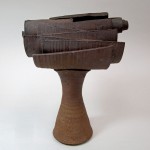
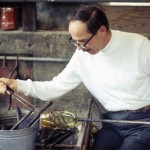
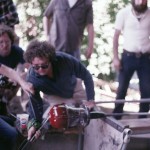
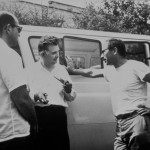
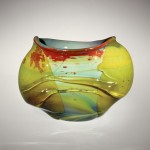
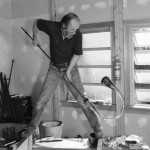
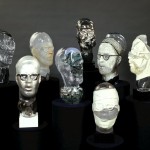
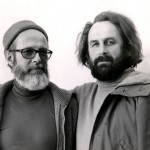
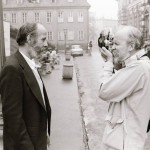
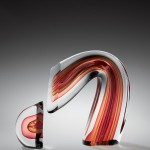
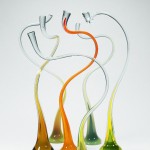
8 comments » Write a comment